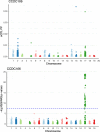This is a preprint.
Cis- and trans-eQTL TWAS of breast and ovarian cancer identify more than 100 risk associated genes in the BCAC and OCAC consortia
- PMID: 38014246
- PMCID: PMC10680675
- DOI: 10.1101/2023.11.09.566218
Cis- and trans-eQTL TWAS of breast and ovarian cancer identify more than 100 risk associated genes in the BCAC and OCAC consortia
Update in
-
Cis- and trans-eQTL TWASs of breast and ovarian cancer identify more than 100 susceptibility genes in the BCAC and OCAC consortia.Am J Hum Genet. 2024 Jun 6;111(6):1084-1099. doi: 10.1016/j.ajhg.2024.04.012. Epub 2024 May 8. Am J Hum Genet. 2024. PMID: 38723630 Free PMC article.
Abstract
Transcriptome-wide association studies (TWAS) have investigated the role of genetically regulated transcriptional activity in the etiologies of breast and ovarian cancer. However, methods performed to date have only considered regulatory effects of risk associated SNPs thought to act in cis on a nearby target gene. With growing evidence for distal (trans) regulatory effects of variants on gene expression, we performed TWAS of breast and ovarian cancer using a Bayesian genome-wide TWAS method (BGW-TWAS) that considers effects of both cis- and trans-expression quantitative trait loci (eQTLs). We applied BGW-TWAS to whole genome and RNA sequencing data in breast and ovarian tissues from the Genotype-Tissue Expression project to train expression imputation models. We applied these models to large-scale GWAS summary statistic data from the Breast Cancer and Ovarian Cancer Association Consortia to identify genes associated with risk of overall breast cancer, non-mucinous epithelial ovarian cancer, and 10 cancer subtypes. We identified 101 genes significantly associated with risk with breast cancer phenotypes and 8 with ovarian phenotypes. These loci include established risk genes and several novel candidate risk loci, such as ACAP3, whose associations are predominantly driven by trans-eQTLs. We replicated several associations using summary statistics from an independent GWAS of these cancer phenotypes. We further used genotype and expression data in normal and tumor breast tissue from the Cancer Genome Atlas to examine the performance of our trained expression imputation models. This work represents a first look into the role of trans-eQTLs in the complex molecular mechanisms underlying these diseases.
Conflict of interest statement
Declaration of Interests The authors declare no competing interests.
Figures



References
-
- Adedokun B., Du Z., Gao G., Ahearn T.U., Lunetta K.L., Zirpoli G., Figueroa J., John E.M., Bernstein L., Zheng W., et al. (2021). Cross-ancestry GWAS meta-analysis identifies six breast cancer loci in African and European ancestry women. Nat. Commun. 12, 4198. 10.1038/s41467-021-24327-x. - DOI - PMC - PubMed
-
- Shu X., Long J., Cai Q., Kweon S.-S., Choi J.-Y., Kubo M., Park S.K., Bolla M.K., Dennis J., Wang Q., et al. (2020). Identification of novel breast cancer susceptibility loci in meta-analyses conducted among Asian and European descendants. Nat. Commun. 11, 1217. 10.1038/s41467-020-15046-w. - DOI - PMC - PubMed
-
- Zhang H., Ahearn T.U., Lecarpentier J., Barnes D., Beesley J., Qi G., Jiang X., O’Mara T.A., Zhao N., Bolla M.K., et al. (2020). Genome-wide association study identifies 32 novel breast cancer susceptibility loci from overall and subtype-specific analyses. Nat. Genet. 52, 572–581. 10.1038/s41588-020-0609-2. - DOI - PMC - PubMed
Publication types
Grants and funding
LinkOut - more resources
Full Text Sources
